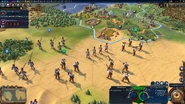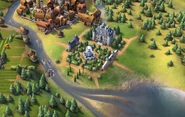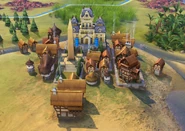The French people represent a civilization in Civilization VI.
They have two different leaders and color palettes: Catherine de Medici, under whom their colors are light blue (#418DFE) and yellow (#EBEB8B), and Eleanor of Aquitaine, under whom their colors are pink (#fa72a8) and yellow (#EBEB8B).
The French civilization ability is Grand Tour, which gives them +20% ![]() Production towards Medieval, Renaissance, and Industrial era wonders and doubles
Production towards Medieval, Renaissance, and Industrial era wonders and doubles ![]() Tourism from wonders of any era. Their unique unit is the Garde Impériale, and their unique tile improvement is the Château.
Tourism from wonders of any era. Their unique unit is the Garde Impériale, and their unique tile improvement is the Château.
Strategy
France under Catherine is quite focused on a Cultural Victory. The extra Spy and diplomatic visibility will help greatly with defending yourself in peacetime, while the Garde Impériale will help you defend yourself in wartime. Set your ![]() Production strong, and Grand Tour will be very powerful. The two most powerful wonders in the game, the Forbidden City and Ruhr Valley, both benefit from Grand Tour's bonus. So do the Bolshoi Theatre and Hermitage, both of which grant significant amounts of
Production strong, and Grand Tour will be very powerful. The two most powerful wonders in the game, the Forbidden City and Ruhr Valley, both benefit from Grand Tour's bonus. So do the Bolshoi Theatre and Hermitage, both of which grant significant amounts of ![]() Tourism.
Tourism.
Civilopedia entry
The French brought civilization haute cuisine, haute couture, haute-contre, and a whole lot of other “hautes.” But the French are not just about culture; they also brought history the Hundred Years' War, the Reign of Terror, Napoleon’s efforts to conquer Europe, etc.
Once the Romans gave up trying to govern the unruly Gauls, a number of Frankish kingdoms rose during the early Dark Ages, most of these lasting but a couple generations. Finally, the medieval Kingdom of France emerged from the western portion of Charlemagne’s empire, that chunk known as West Francia. With the death of the last Carolingian king, to avoid the bloodshed of a dynastic civil war, the Archbishop of Reims convened the great lords of Francia to elect a new ruler. Duke Hugh Capet of the demesne Ile-de-France was eventually chosen as king, and crowned Rex Francorum by the prelate of Reims in July 987 AD. At one stroke, modern France was created and its longest reigning dynasty (from this date to 1848, with a few unfortunate interruptions) installed.
The long rule of the Capetians has several foundations. The Capetian kings were inevitably Catholic, although with widely varying piety, and hence closely allied with the Church, which favored a strong central government in France. The line came to be recognized by other monarchs (except those stubborn English) as illustrious and ancient, and therefore inherently superior to anyone else available. The Capetians also tended to enjoy fairly harmonious familial relations, exceptional when it came time for a succession. By tradition, the king’s younger brothers were given appanages (duchies, counties, towns and the like) to mitigate any lingering bitterness over the rule of primogeniture (of course, sisters didn’t get any such, and were usually married off as quickly as possible after a succession). Save for the religious in-fighting between the Catholics and the Huguenots, France managed to avoid the civil wars that plagued most of their neighbors. Trade, the arts and the crafts would flourish under them, as well as religion (well, Catholicism anyway) and education – the University of Paris, or Sorbonne, was founded c. 1150 – so they generally had the support of the common folk.
The next couple centuries would see the power and influence of the Capetians grow, although there were some missteps – such as getting involved in a half dozen Crusades to liberate the Holy Land, meddling in the squabbles of the Italian city-states, suppressing heretical movements in France (usually with a great deal of blood), slaughtering the Knights Templar in 1312 to seize their wealth, and, of course, the Hundred Years' War (which actually ran 116 years, but who’s counting).
As the fourteenth century (by European reckoning) dawned, France was the most powerful country on the continent. In 1328, Philip VI assumed the throne. The Plantagenets, kings of England, owned Aquitaine and had a slender claim to the French throne, which they hadn’t pressed at the time of Philip VI’s succession. However, in 1337 Philip VI confiscated Aquitaine, and the now thoroughly annoyed King Edward III of England reinstated his claim, bringing the two dynasties to war. In July 1346 Edward invaded and, after much marching about, won the famous “battle” (more a slaughter of the arrogant French knights) at Crecy and captured the port of Calais. Then the Black Death cropped up, and lots of folk died, delaying further campaigning – thoroughly vexing a new generation of nobles.
By 1356 the plague had passed so the bloodshed resumed. In September of that year, the French king managed to get himself captured and most of his nobles killed off at Poitiers against Edward, the Black Prince. (The French refused to pay their king’s ransom, and so John II died in captivity.) The war dragged on until Agincourt (yet another glorious slaughter), after which the Treaty of Troyes in 1420 declared the unification of the French and English crowns on the infant head of Henry VI, king of England and now France. This did not sit well with everyone. The dauphin Charles VII was declared illegitimate and bypassed, though many French patriots preferred any Frenchman to any English ruler. This included a strange (to put it mildly … she heard voices and experienced visions from God) peasant woman named Joan. Within a few years Joan of Arc had inspired the French to victory, driving the English back on all fronts. Charles was anointed king in 1429, and saintly Joan got burned at the stake.
The upshot of all this was that the House of Valois, a cadet branch of the Capetians, now sat on the throne of France. These later Capetians held more power and were considerably more influential than the previous ones. Whereas Philip I (the Amorous, 1060-1108) could barely control his unruly Parisian barons, the Bourbon (another cadet branch) Henry IV (1589-1610) could challenge both the Pope and the Hapsburg Holy Roman Emperor. These kings, although they usually ruled for shorter periods, had far more impact on the course of civilization than their predecessors.
During the reigns of the glorious Louis’s – XIII the Just, XIV the Sun King, XV the Beloved, the unfortunate XVI (the guillotined) – France became a power second to none on the continent, as well as the center of European culture and refinement. The XIIIth saw explorers and colonists spread or impose French tastes across the globe, in North Africa, the Americas and Asia as France joined the race for colonies. Under the long-reigning le Roi-Soleil, the last vestiges of feudalism disappeared (although the former serfs might not know it) and Versailles was completed (mostly). Great generals, such as Turenne and Vauban, and great writers, such as Molière and Racine, as well as those gifted in other artistic pursuits, flourished. Madam de Pompadour, one of the most famous mistresses of all time, had an enormous influence on the arts – notably architecture and interior design (those pricy Louis Quinze pieces) – under the doting patronage of Louis XV. France went from grim gothic to gilded rococo in two generations. But the Ancien Régime came crashing down in 1789.
Being somewhat distressed by the gap between the haves and have-nots, in that year the citizens of Paris stormed the Bastille in July and threw off the shackles of monarchy. Republicanism was afoot and revolution spread through the land. Inflamed by the concepts of liberté, égalité, fraternité and those nice young men Robespierre, Danton and Marat, they instituted the Reign of Terror, using the “humane” guillotine to execute thousands of the privileged and anyone else who ran afoul of the Committee for Public Safety. The Constitution of June 1793 established the French First Republic; most of its authors were later imprisoned or guillotined. The rest of the crown heads of Europe couldn’t have all these liberal ideas floating about, and in short order the First Coalition (Austria, Prussia, Great Britain, and Spain among others) attacked France.
In 1795 the elective five-member Directory was established to govern, but they didn’t fare so well. Building on his battlefield successes for the Republic, in a coup d’état in November 1799 that Corsican Napoleon Bonaparte removed the Directors and so launched the French First Empire. For the next decade-and-a-half, the French would battle successive coalitions (six in all), generally beating them soundly. But the sheer weight of forces arrayed against Napoleon was telling. On the fringes, in Iberia and Russia, France lost thousands of men. The ever stubborn British controlled the seas. Napoleon even had to sell Louisiana to the infant United States just to make ends meet. Finally, the Sixth Coalition, following the historic retreat from Russia, defeated the Grande Armée at Leipzig, entered Paris in March 1814, exiled Napoleon to Elba, and reinstalled the Bourbon Monarchy.
But all that didn’t last long. Bonaparte returned to France and raised yet another army. Louis XVIII, suffering from gout and having some sense, fled Paris to go into hiding in the Netherlands. The monarchs of Europe had to create yet another coalition, and after 100 days of excitement, routed the French at the Battle of Waterloo. Napoleon was again shipped off to an island prison (where he eventually died in 1821 at the age of 51). France was a kingdom again … well at least until 1848. Yet another revolution, not much better organized than the first, overthrew the Capetians once and for all and established the Second Republic. Which lasted only three years until Louis-Napoleon Bonaparte, following his uncle’s footsteps, overthrew those libertarians and so founded the Second French Empire.
And that in turn lasted only until 1870, when Napoleon III got himself captured by the Prussians at the Battle of Sedan during the Franco-Prussian War. The National Assembly was invaded by a Parisian mob, who demanded a change. The delegates, no fools, promptly created the Third Republic. The Empress fled for England and republicanism once again ran amok in France. They just couldn’t quite seem to get it right. (The Prussians, in the process, got Alsace-Lorraine and unified Germany … but that’s another story.)
The Third Republic did fairly well, all things considered. It made friends with England and Russia and the United States. It managed to solidify its grasp on the tattered remnants of its overseas colonial holdings. Decadent Paris became the world’s guilty pleasure; like moths to a flame, tourists flocked to the Moulin Rouge, the Left Bank, Le Crazy Horse Saloon and the Bal Bullier. The roots of avant-garde art flourished; the belle époque was in full swing. The French set the standards for fashions, foods and fads. France even managed to survive the First World War without another change in government, although the Pyrrhic victory left it devastated and impoverished.
Indeed, the Third Republic managed to survive until 1940, when replaced by the Vichy government, which filled up the part of France the Third Reich didn’t bother to occupy. After four brutal years, metropolitan France was liberated by the English and Americans – despite de Gaulle’s claims for the “Free French” forces – in summer and autumn 1944. By 1945 Nazi Germany was defeated; the Second World War was over. It was time for yet another government, this time the Fourth Republic, when a new constitution was adopted in October 1946.
The trigger for the collapse of the Fourth Republic (yes, another one) was the Algerian Crisis of 1958. Having been truly devastated by world war, the French leaders had spent even more blood trying to hang on to a decaying colonial empire, notably in Indo-China and in Algeria. The Suez Crisis in 1956 was yet another disaster for France. In May 1958, the National assembly brought de Gaulle back to power; he quickly dissolved the Fourth and created a Fifth, based on his “Politics of Grandeur,” declaring that grandeur was essential to the nature of France. And it’s been that way ever since.
Cities
Citizens
Males:
- Alban
- Benoit
- Christophe
- Corentin
- Déodat
- Émeric
- Judicael
- Laurent
- Renaud
- Yves
Females:
- Aalis
- Adélaide
- Blanche
- Céleste
- Daphné
- Élise
- Geneviève
- Jocelyne
- Solange
- Tiphaine
- Charlotte
- Isabelle
Modern males:
- Antoine
- Armand
- Claude
- Dacey
- Jerome
- Marcel
- Orvil
- Percival
- Tristan
- Verne
Modern females:
- Babette
- Delphine
- Gabrielle
- Honoré
- Linette
- Noelle
- Odette
- Renée
- Severin
- Yevette
Trivia
- The French civilization's symbol is the fleur-de-lis, which has a long history of use in French heraldry.
- The French civilization ability is named after the traditional trip through Europe undertaken mainly by aristocratic men in the 17th and 18th centuries, which is considered a precursor for modern-age cultural tourism.
Gallery
Videos
Related achievements

|
Blackest Queen
As France, build an Intelligence Agency
|

|
Loire Valley
Create 5 Châteaux in one city with the Wine resource.
|

|
Valois Dynasty
Win a regular game as Catherine De Medici
|




